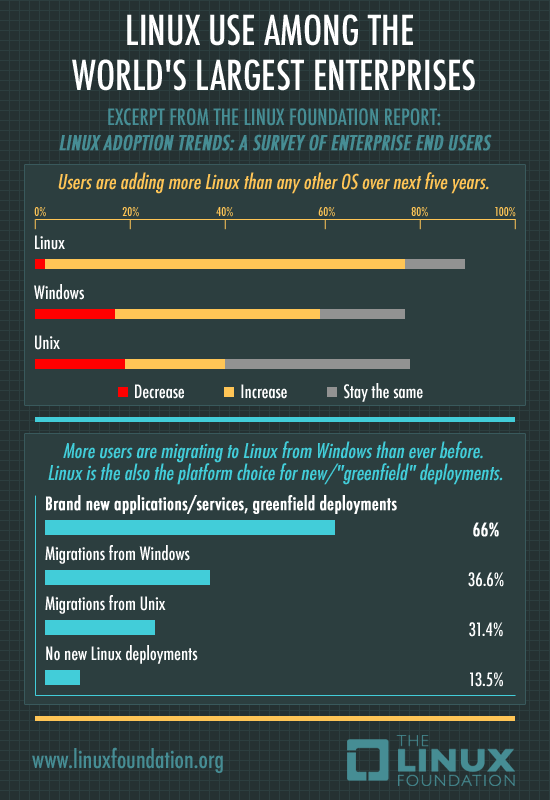For years, Linux has enjoyed much of its success as a replacement for Unix. Companies turned to Linux to replace Unix servers, or for new deployments within a Unix-heavy environment. Linux is still king there, but it’s starting to encroach on Microsoft as well.
That’s the word from the Linux Foundation’s report on adoption trends. The report was conducted by the Yeoman Technology Group, and surveyed nearly 2,000 users picked by the Linux Foundation End User Council. The results released yesterday were culled from 387 respondents that are from the largest organizations — companies with more than 500 employees and/or more than $500 million a year in revenue.
Conclusions
Since the organizations surveyed were picked by the Linux Foundation End User Council, there’s naturally going to be some happy Linux users in the bunch. The numbers are still a bit surprising, though.
Big companies are planning overwhelmingly (76.4%) to add more Linux servers in the next year, and less than half (41.2%) of the companies are planning to add Windows servers in the next year. Even more interesting, nearly half (43.6%) are actively planning to decrease use of Windows servers in the next year.
Linux: It’s Not Just for LAMP Anymore
And companies are putting Linux in more mission-critical areas, as opposed to the edge use that Linux enjoyed in its early adopter years. Linux has moved beyond the platform for Apache, Perl/PHP, and MySQL and into a starring role in the server room — 60% of respondents say that Linux is going to be used for more mission critical workloads.
More than 66% of the companies are deploying new applications on Linux, 36% are migrating from Windows, and 31.4% are migrating from Unix to Linux.
And it’s not just because companies want to cheap out. CIOs see Linux as more strategic, and less as a way to just cut costs. Features and technical superiority came in at 67.5% as the primary driver for adopting Linux. Though cutting costs still factors in, 65.4% said lower TCO is a factor, it’s not just about money — it’s about control, and being part of the community.
Contributions, Contributions, Contributions
Most analysts focus on the dollars and server volume, but there’s more to Linux’s success than that. Specifically, growing the contributor community and ensuring that the software continues to improve. That shouldn’t fall entirely on the shoulders of Linux vendors like Red Hat, Novell, and Canonical, or projects like Debian. Some of that needs to come from the businesses and organizations that have deployed Linux.
As Jeffrey Hammond pointed out during his crossing the chasm talk at LinuxCon this summer, companies that get involved with open source deploy more open source and continue to use Linux.
This is borne out in the Foundation study as well. Nearly 50% of the respondents said that ability to modify code was a reason to adopt Linux, and 45.8% said that long-term viability of the platform is a reason to adopt Linux.
More than a third of businesses say that they test and submit bug reports, and 13.4% actively contribute code. That’s less than one-fifth of businesses actively submitting code, but it’s 13.4% more than are actively contributing to Windows or proprietary Unix. Testing and bug reporting are also active contributions, so well more than one-third of businesses that do more than $500 million in business per year are contributing to Linux.
For the full scoop, read the report. The bottom line? The future is very bright for Linux in large organizations.


